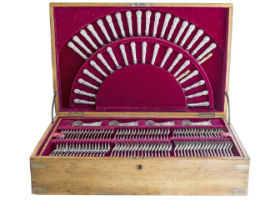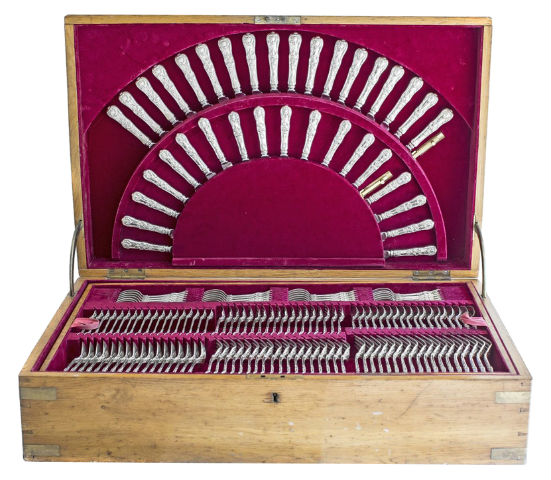
NEW YORK — The appeal of buying antiques lies in their quality craftsmanship and the history each object holds and the stories it tells. This is especially true with sterling silver flatware, which continues to entice collectors.
Setting the table with finely made old silver that graced dining rooms a generation ago makes the table sparkle and conjures up centuries-old artistic traditions. Why would anyone want to buy new, mass-produced flatware when they could buy an older set of silver that is not only historically important but a work of art in itself? The “green” aspect to antiques is also a leading reason to buy, particularly with younger consumers, who actively seek to reduce waste and consumption by buying old instead of new.
In the mid-20th century, a flatware set was a popular wedding gift (and still is), usually from the bride’s parents or a close relative. Collectors and those who appreciate fine silver continue to covet these pieces and appreciate their marriage of form and function.
“You are buying a piece of history,” said Albert Levy, owner of A.B. Levy’s in Palm Beach, Fla., noting one can often purchase great antique sterling flatware for good prices and flatware is a good investment. “The maker is more collectible than the pattern. A Tiffany set is always more popular than a Gorham set. Buccellati also created beautiful flatware.”
At the upper end of flatware makers, not surprisingly, is Tiffany, based in New York City, which came out with its first pattern in 1847 and transformed fine dining into art. Weighty pieces owing to the amount of silver that Tiffany used, each piece is also hand-finished, giving it a warm glow.
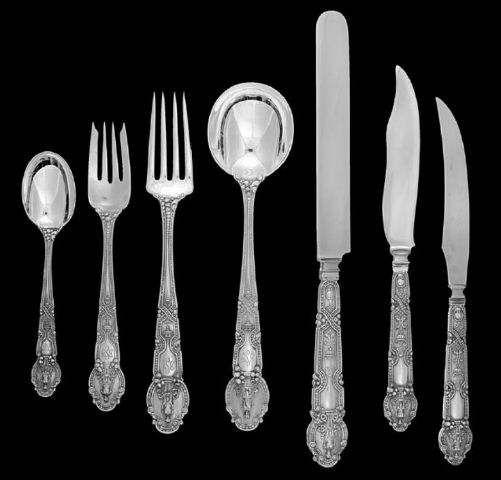
Among Tiffany’s many flatware patterns, an especially noteworthy one was “Renaissance,” which was designed by George Paulding Farnham (1859-1927) in 1904, his last design. Interestingly, while this “Gilded Age” pattern was patented in 1904, manufacture began a year later and it didn’t grace Tiffany’s iconic Blue Book until 1907. The subtle multi-motif styling of the pattern ensured its longevity even as tastes change over time. The pattern was eventually retired in the 1940s, however.
“Renaissance is a multi-motif pattern, meaning that the decoration on some pieces varies somewhat. The oyster forks have seaweed, fish and shells instead of flowers by the pilaster. The knives have ram’s heads on the side,” according to an online blurb posted by Spencer Marks Ltd. in Southampton, Mass. “Paulding Farnham, Tiffany’s master jewelry and silver designer at the turn of the century, designed this pattern in 1904. Although he designed other patterns, this is his best known and most coveted pattern. It is a tour-de-force of high relief casting and displays his mastery of historical design.”
While Tiffany may bring the biggest bang for the buck when it comes to the auction and resale market, several other American silver makers are equally known for their flatware.
Founded in Providence, R.I., in 1831, the Gorham Manufacturing Co. sought to transform mealtime into an event with its heirloom pieces. Its silversmiths have been making flatware since the company’s founding and many of its designs are highly collectible, ranging from the simple to the sublime.
Giving a shot in the arm to American silversmiths over their overseas counterparts, Congress passed a tariff that served to stop the importing of silverware into the United States.
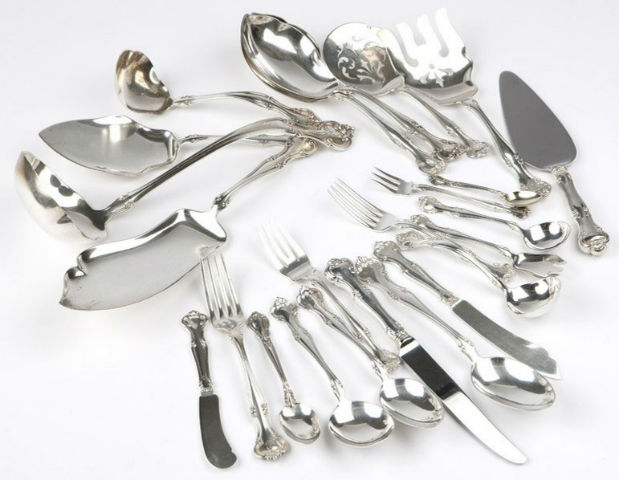
The golden age of American silversmithing was about 1850 to 1940 and Gorham was prolific, creating many popular patterns. One of its most famous patterns is “Chantilly,” designed in 1895 by one of Gorham’s most talented designers, William C. Codman. “The elegant curves in the Chantilly handle achieve a balance ‘between the excessively ornate and the unduly severe,” according to an online description posted by the Beverly Bremer Silver Shop.
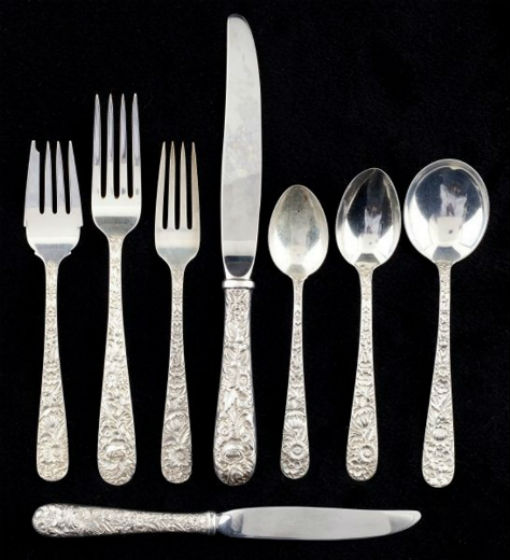
Other American silversmiths of note included Baltimore’s Samuel Kirk & Sons and the Stieff Company. Both companies were famous for bringing back the Repousse style in relief, which is difficult to do by hand but can achieve stunning and ornate looks. The two companies merged in 1979. Among their notable patterns are “Repousse,” “Chrysanthemum,” and “Golden Winslow,” possibly its oldest pattern, dating back to 1850. Also well known for their sterling flatware were J.E. Caldwell & Co, founded in Philadelphia in 1839 by James Emott Caldwell (1813-81) and Reed & Barton of Taunton, Mass., which was originally founded in 1824 as Babbitt & Crossman but renamed in 1840 when the firm was bought out by two of its craftsmen.
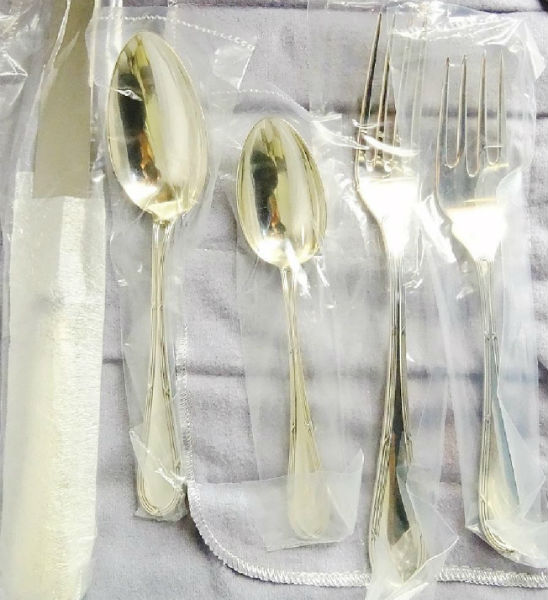
Among European sterling silver flatware makers popular in America is Buccellati. Mario Buccellati launched his first boutique in Milan, Italy, in 1919. Its flatware patterns — and much of its other work, including jewelry — are influenced by Renaissance motifs and nature. A classic pattern is “Esteval,” which used local flora as its inspiration. Launched circa 1920, it was manufactured until 2001.
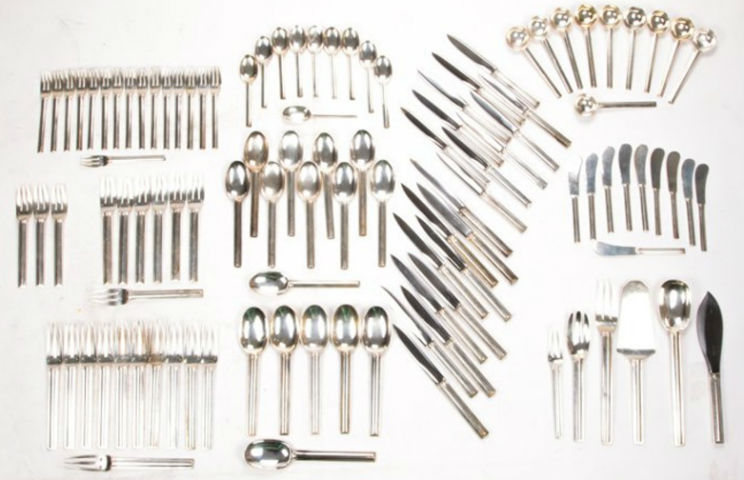
Levy offered buying tips for new collectors. “Always ask for condition reports and always make sure you are dealing with a great auctioneer or gallery because you always to want to be sure you get what you pay for.”
And instead of just hauling out the good silver for holidays or special occasions, use it as often as you like and truly enjoy the beauty of these pieces to make everyday meals special. Just avoid hard water and don’t put them in the dishwasher with stainless steel flatware to avoid damaging them.


